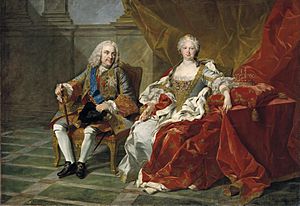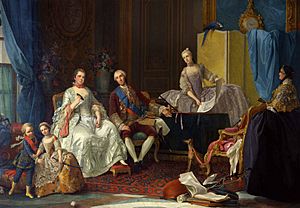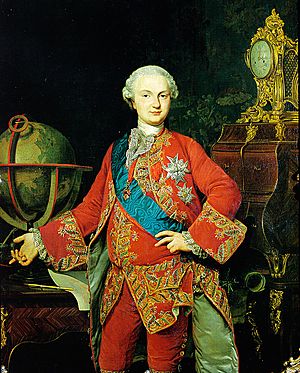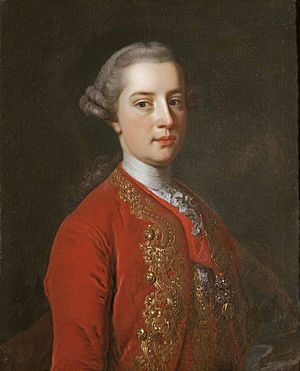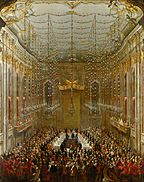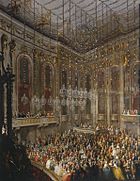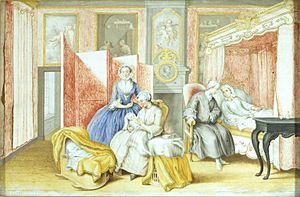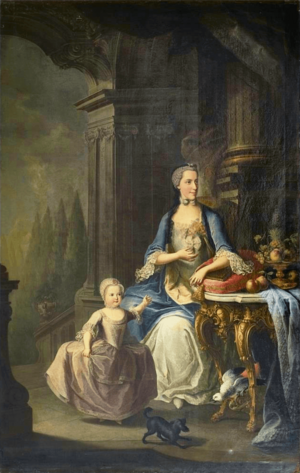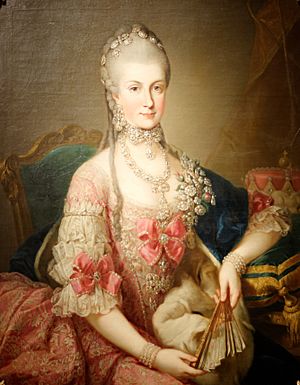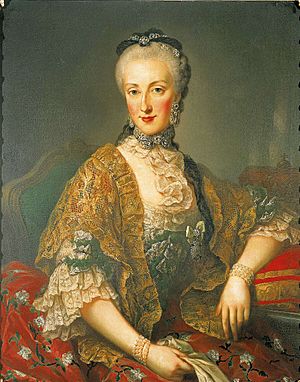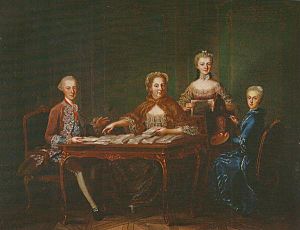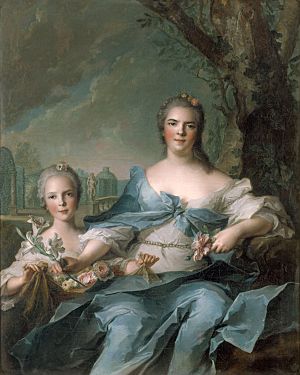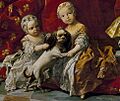Princess Isabella of Parma facts for kids
Quick facts for kids Princess Isabella of Parma |
|||||
|---|---|---|---|---|---|
| Archduchess of Austria | |||||
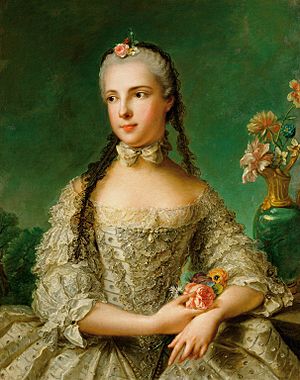
Portrait by Jean-Marc Nattier, 1758
|
|||||
| Born | 31 December 1741 Buen Retiro Palace, Madrid, Kingdom of Spain |
||||
| Died | 27 November 1763 (aged 21) Hofburg, Vienna, Archduchy of Austria, Holy Roman Empire |
||||
| Burial | Maria Theresa Vault, Imperial Crypt, Capuchin Church, Vienna, Austria | ||||
| Spouse | |||||
| Issue |
|
||||
|
|||||
| House | House of Bourbon-Parma (by birth) House of Habsburg-Lorraine (by marriage) |
||||
| Father | Philip, Duke of Parma | ||||
| Mother | Louise Élisabeth of France | ||||
| Religion | Roman Catholicism | ||||
Isabella of Bourbon-Parma (born December 31, 1741 – died November 27, 1763) was a princess from Parma and Spain. She belonged to the House of Bourbon-Parma. In 1760, she married Archduke Joseph of Austria. This marriage made her an Archduchess of Austria and a future empress.
Isabella's husband loved her very much. However, she found a closer friend in her sister-in-law, Maria Christina. Isabella had a difficult childhood. She also faced the loss of her mother and challenging pregnancies. These experiences made her feel very sad and worried. She died young, at the age of 21, from smallpox.
Contents
Isabella's Early Life
Birth and Family
Isabella was born on December 31, 1741. Her birthplace was the Buen Retiro Palace in Madrid, Spain. She was the first child of Philip of Spain and Marie Louise Élisabeth of France.
Isabella's parents were cousins. Her mother was only 12 when she married Philip, who was 19. Élisabeth felt it was beneath her to marry someone who was not a king or a future king. Philip was only the third son of the King of Spain. Élisabeth was more ambitious than her husband. She often had disagreements with her mother-in-law, Queen Elisabeth Farnese.
Isabella's mother was only 14 when Isabella was born. The birth was difficult and lasted two days. Two months later, Philip left to fight in a war. He did not see his family again for eight years. Isabella's mother did not show much affection towards her. She likely found having a baby to be a burden.
Childhood in Madrid (1741–1748)
For her first seven years, Isabella grew up in the royal court of her grandfather, King Philip V of Spain. Her grandmother, Queen Elisabeth, loved her deeply. She often wrote about Isabella's well-being in letters. When Isabella was three, she started having tantrums. Her mother scolded her very harshly. Queen Elisabeth thought it was like a military drill. This is the only time her mother and daughter's interaction was recorded. Letters show her mother was impatient with Isabella. She called Isabella 'stubborn' and 'unbearable'.
After she stopped breastfeeding, Isabella's care was given to her governess. This was María Catalina, Marchioness of Gonzalez. She was a strict widow who always wore black. The Marchioness had a strong sense of proper behavior.
Isabella was an energetic and playful child. She was often loud, jumping, climbing, and falling. She broke expensive furniture and decorations. Her favorite activities included chasing butterflies, horse-riding, and doing stunts on a rope. She also liked to write, sing, and draw. Her governess eventually took away her ropes, horses, and swings. This was an attempt to make her behave better. Isabella wrote that she learned to be 'reasonable'. After that, she entertained herself quietly. Her childhood was described as 'lonely and strict'. Still, she became very close to her governess. This made her mother jealous.
Isabella's education prepared her to be a princess. In 1746, a French visitor praised the four-year-old infanta. He noted her dignified way of receiving people. He said she already knew 'who she is, to whom she belongs, and what she must be one day'. He also found her 'very big' for her age and 'lovely'. The visitor also noticed how coldly Isabella's mother treated her.
Visit to Versailles (1749)

From January to October 1749, Isabella lived in Versailles. Her mother was visiting her family on her way to their new home in Parma. As the only granddaughter of King Louis XV and Queen Marie Leszczyńska, Isabella was spoiled. Her grandparents and aunts gave her more attention and love than she had ever known. The luxury and cheerfulness of the French court surprised Isabella. It was very different from the strict Spanish court.
At eight years old, Isabella could join in many court events. She visited many theatres and operas. She also attended balls and concerts. At first, she seemed shy at most performances. She was more comfortable speaking Spanish than French.
Eventually, she overcame her shyness and enjoyed her stay. She especially liked going with her grandmother, Queen Marie, to the Salon of Peace. There, operas, plays, or music were performed almost daily. She was also happy to be treated as a French royal princess. The King ordered that she rank as high as her mother and aunts. The royal guard always saluted her. She sat in an identical armchair to the other princesses. She even performed for the dauphine, Maria Josepha of Saxony. Everyone praised her. After her visit to Versailles, she continued to write to her mother's family. French became her main language.
Teen Years in Parma (1749–1760)
In 1748, the Treaty of Aix-la-Chapelle made Isabella's father the Duke of Parma and Piacenza. This made Isabella a princess of Parma. She arrived in her new home with her mother on November 20, 1749.
Parma was poor, and its palaces were in ruins. Isabella thought Italians were 'ignorant'. She wanted to leave the country as soon as she arrived. Her mother also complained about the poverty. She focused on arranging good marriages for her children. She wanted Isabella to marry a king or an emperor. She visited Versailles twice to negotiate. Both times, she left her husband and children in Parma. She died during her last visit in 1757.
Isabella's parents had two more children in 1751: Ferdinand and Luisa. Isabella seemed happy to have siblings. During her mother's long trips, Isabella acted as a mother figure. She reported on her siblings' well-being to her father and grandmother. The Duke lived apart from his children for seven months each year. Isabella sent him notes about the babies.
Isabella's mother was questioned about her coldness towards Isabella. She replied that her 'character was too serious' to be a friend to her daughter. She believed Isabella should be 'satisfied' with the affection shown. A French official urged her to be more tender. Élisabeth then protested her maternal love.
Education
Isabella's education continued under the Marchioness of Gonzalez. In 1749, her father hired Pierre Cerou. He was a Frenchman who taught her history, literature, and French. In 1754, the Madrid court wanted him replaced by a Jesuit. Élisabeth resisted, fearing a Jesuit would control her son. They agreed on a French Jesuit, Thomas Fumeron. From 1754, Isabella had no tutor. Later, a governor and tutor were hired for Ferdinand.
Isabella was officially taught by her confessors. They taught her about the lives of saints. Her education focused on drawing, painting, and music. She was excellent at singing and playing the violin and harpsichord. She also learned about military theory and history. Austrian observers noted Isabella spoke four languages. She studied sciences and maps. She also followed military movements. In 1758, a historian described Isabella as a 'main wonder' of Parma. She had a 'marked talent' in all 'useful and pleasurable arts'. She also had good knowledge of the world.
Isabella saw the harsh treatment of her brother by his tutors. She later wrote about it in her Réflexions sur l'éducation. She condemned how her brother was raised. She kept in touch with one tutor, but rarely mentioned the other.
Life in Vienna
Marriage to Archduke Joseph
Background
Maria Theresa, the Holy Roman Empress, wanted to strengthen ties between royal families. She aimed to connect the Bourbon and Habsburg families through marriage. In 1751, her advisor, State Chancellor Kaunitz, asked for a report on Isabella. She was a possible bride for one of the Empress's sons. He was pleased with Isabella's skills. She danced gracefully, played music, and spoke French, Spanish, and Italian. She was also learning Latin.
When Maria Theresa's eldest son, Archduke Joseph, grew up, he was given a list of princesses. He chose Isabella. Joseph was not eager to marry. He had a low opinion of women. His engagement to Isabella's cousin was broken off for political reasons. Isabella's mother led the marriage negotiations. The contract was finalized in 1759. Soon after, her mother died of smallpox. This deeply saddened Isabella. She may have started to believe she would also die young.
After the engagement, the courts waited for the couple to mature. Her mother's death caused further delays. Isabella began learning German, studying seven hours a day. A detailed description of her character was sent to Vienna. It praised Isabella as beautiful and kind. She was dignified but not fake. She enjoyed reading and music. She preferred brisk walks over card games or hunting. Isabella gave much of her money to the poor in Parma. She wanted to please her future mother-in-law, the Empress. Isabella prepared carefully for her future. She paid attention to the political situation. She was ready to pretend and manipulate to please her new family.
Before the wedding, Joseph wrote that he would try to earn his bride's respect. But he found it impossible to 'pose as a lover'. He felt melancholic about the wedding.
Wedding
Isabella traveled to Vienna in late 1760. She was sad to leave her family but happy to leave Parma. Maria Theresa did not allow any of Isabella's old staff to come with her. Isabella acted brave in public. But in private, she cried a lot when saying goodbye to her family.
They traveled through the Alps. They were met at the border by Countess Erdődy, Isabella's new head lady-in-waiting. They reached a castle near Vienna on October 1. There, they met her future father-in-law, Francis I, Holy Roman Emperor. They then went to Laxenburg castles to meet the rest of the imperial family. Isabella charmed almost everyone. Her groom, Joseph, turned red when he saw her. He now could not wait for the wedding.
The Emperor, Empress, and archdukes were all enchanted by her. Maria Christina wrote that Isabella was very attractive. Empress Maria Theresa thought she was perfect. Everyone agreed she was pretty and interesting. The only person who disliked her was the eldest archduchess, Maria Anna. She was jealous because Isabella was instantly adored.

After arriving in Vienna, Isabella stayed at the Belvedere. This was separate from her new family. The wedding took place on October 6. Guests rode in 120 gilded carriages to the Augustinerkirche. Musicians played, and crowds cheered. The wedding was celebrated by Vitaliano Borromeo.
After the ceremony, Vienna was lit up. Almost 3,000 lanterns burned between the Hofburg and Stephansdom. There were also many white wax candles and torches. That night, there was a public banquet at the Hofburg. Isabella's pure gold tableware from her dowry was used. The wedding festival lasted for days. It was painted by Martin van Meytens. These paintings can be seen in Schönbrunn Palace. This grand event happened even during the Seven Years' War. Maria Theresa wanted to show her empire's wealth.
Married Life and Relationship with Her Husband
Joseph fell in love with Isabella and was a caring husband. But she did not fully return his feelings. The court noticed that Joseph loved her deeply. He showed her much affection, but she remained reserved. As an archduchess, she had to have an heir quickly. Everyone was happy when she became pregnant in late 1761. She was relieved not to disappoint her family. She behaved bravely during pregnancy, as Maria Theresa noted.
Her pregnancy was difficult. She had many physical symptoms and felt very sad. She also had a strong fear of death. Her husband did not understand her problems. On March 20, 1762, she gave birth to a daughter, Maria Theresa. The court rejoiced, and Joseph adored the baby. How Isabella felt about her child is not well known. She only mentioned her once in her private letters. A friend said her love for her child 'did not show much on the exterior'.
Soon, she was pregnant again. She had a miscarriage in August 1762, and another in January 1763. Maria Theresa worried and told Joseph to wait six months before trying for another child. Isabella's health suffered. She became very thin and had a cough. Her pregnancies and miscarriages made her sadness worse. This made her want to live less. Her fear of death grew due to the risks of childbirth.
Meanwhile, her husband and mother-in-law loved her even more. Isabella seemed to find a mother figure in the Empress. She appeared submissive to both her husband and mother-in-law.
Friendship with Archduchess Maria Christina
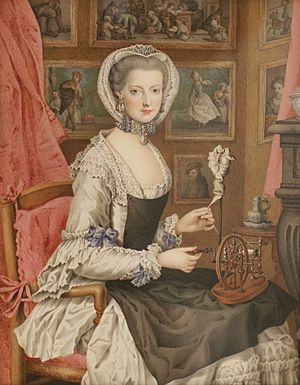
Her sister-in-law, Maria Christina (called Marie or Mimi), was Isabella's best friend. She was Isabella's closest confidante in Vienna. Marie was the third child of the Empress. She was less than five months younger than Isabella. She was the Empress's favorite child, intelligent and artistic. The two quickly became very close. They spent so much time together that people compared them to Orpheus and Eurydice. Even though they lived in the same palace, they wrote many letters and notes in French. Only Isabella's letters survived. Marie burned hers after Isabella's death. Still, nearly 200 of Isabella's letters remain.
The two sisters-in-law liked each other from their first meeting. Soon after Isabella arrived, she began to playfully 'court' Marie.
At first, Isabella addressed Marie formally. But soon, she used loving nicknames like 'my dear angel' and 'my most precious treasure'. She often described them as a couple. She called herself Marie's 'lover'.
They met in secret places. Isabella even wrote notes to Marie during church services. They exchanged gifts. If Joseph's hunting trip was canceled, they would cancel their plans too. They were careful to keep their relationship a secret. Isabella wrote to Marie, reminding her not to talk about something, saying 'there is nothing in the world as shameful as going against nature'.
Some historians thought their letters were just overly emotional expressions of friendship. But later, it became accepted that they had a secret, close relationship.
Marie seemed to be the great love of Isabella's life. Marie appeared more reserved but returned her feelings. This difference made Isabella unhappy. Their shared belief that their feelings were wrong led to guilt. Isabella also felt guilty for not fully loving her husband. This made her sadness worse. She became convinced that death was the only solution. She wrote to Marie that she would gladly leave this life.
Relationship with Archduchess Maria Anna
While most of her family loved her, Isabella's relationship with her eldest sister-in-law, Maria Anna (Marianne), worsened. Isabella was beautiful and charming. Marianne was considered less attractive and often ignored by her family. Isabella was also very intelligent. Sciences were Marianne's comfort, which she shared with her father, Emperor Francis. But now, he also adored Isabella. Isabella was even a better singer and violinist than Marianne. Marianne saw Isabella as a rival. She greeted Isabella coldly at their first meeting.
Marianne's coldness, caused by jealousy, hurt Isabella deeply. Isabella decided not to trust her. She thought Marianne was false and hypocritical. It seems Marianne was the only one who suspected the close relationship between Isabella and Marie. She spied on them. Isabella often warned Marie in letters to keep their exchanges secret from Marianne. Isabella's writing, The Charms of False Friendship, was clearly about Marianne. The two women exchanged hugs and compliments in public. Their growing hostility worsened the distant relationship between Marianne and Joseph. After Isabella's death, Joseph never forgave his sister for not loving his wife. As emperor, he later used his power to get revenge on Marianne.
Death and Aftermath
The imperial court spent summers in Schönbrunn. In 1763, they returned to the Hofburg on November 14. Isabella did not want to travel back. She was heavily pregnant, and there were reports of smallpox in Vienna. A few days after arriving, on November 18, Isabella developed a fever. It became clear she had smallpox. The Empress, who had nursed her before, was asked to leave. She had not had the disease yet. Joseph, Marianne, and Marie then took care of Isabella. The fever caused her to go into labor three months early. On November 22, she gave birth to a second daughter. The baby was named Maria Christina, as Isabella had asked. But the baby died the same day.
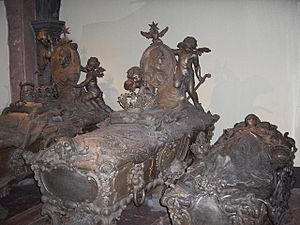
After the birth, Isabella was rarely conscious. She showed courage, almost indifference. The smell from her room was very strong. Most people could not pass the door. But Joseph stayed by her side without a break. On November 26, doctors told him Isabella was dying. She died the next day at dawn, a month before her 22nd birthday. Her body was still infectious. It was buried quickly without an autopsy or embalming. She was placed in the Maria Theresa Vault of the Imperial Crypt. Her daughter Christina's tomb was placed beneath hers. The Empress ordered an unusually long mourning period of three months.
This tragedy, along with the deaths of other imperial children from smallpox, led to a change. In 1768, Maria Theresa decided to have younger family members vaccinated. This helped the practice become accepted in Austria.
Impact on Her Husband
Joseph was heartbroken by Isabella's death. He never fully recovered. His mother insisted he remarry in 1765 to Maria Josepha of Bavaria. Their marriage was unhappy and childless. She also died of smallpox two years later. Joseph adored his only child, Maria Theresa. She died in 1770, at age 7, from pleurisy. The love he felt for Isabella brought out his good qualities. But after her death, he became closed off. He grew more sarcastic, irritable, and aggressive.
Impact on Archduchess Maria Christina
There is no record of Marie's reaction to Isabella's death. She stayed with Isabella until the end. She also cared for Isabella's daughter until the girl died at age seven. Maria Theresa wrote that Isabella gave her papers to her mother-in-law before she died. Isabella said 'not everything was viewable' for Joseph. The Empress then asked Isabella's former lady-in-waiting to collect and burn all of Isabella's writings. She said it would be her greatest service to the family.
In 1766, Marie married Prince Albert Casimir of Saxony. She was the only one of the Empress's children to choose her own spouse and marry for love. After Marie's death, a small portrait of Isabella and her daughter Maria Theresa was found in her prayer book. On the back, Marie had written the date and cause of Isabella's death. She also wrote that Isabella was her best and truest friend. She said Isabella had 'lived as an angel and died as an angel'.
The letters Isabella wrote to Marie were also found among Marie's papers. Marie's husband read them. He then passed them down in the family. Albert understood the letters as proof of an exceptional friendship. The letters can now be found in the National Archives of Hungary. Parts of them were published in the late 1800s. A more complete edition was published in 2008 by Élisabeth Badinter.
Isabella's Writings
Isabella left many writings from her marriage. She wrote about her life, her ideas, and the world. She wrote a funny autobiography called The Adventures of Amazement. In her Christian Reflections, published after Maria Theresa's death, she thought about religious questions and death. She also planned a study called On the Customs of Peoples. She only wrote about Ancient Egyptians before she died. Another short writing discussed Vienna's efforts to join world trade. A piece called The Charms of False Friendship was about her sister-in-law Marianne.
Reflections on Education
Isabella's Reflections on Education rejected traditional ways of raising children. She specifically criticized the cruel tutors of her brother. She also blamed parents for putting strangers in charge. She believed parents were fully responsible for their children. She thought only lazy or weak parents let others raise their children. Her main idea was to avoid being too strict and using corporal punishment. She said authority meant 'requiring everything without listening to the child'. It meant ordering, punishing, and rewarding without showing satisfaction.
Isabella believed that stopping children's natural energy made them violent and stubborn. Such treatment would also take away their good will and trust. It would leave only a 'servile fear' of shame. Abusing parental power, she thought, made children feel like slaves. To cope, they became 'unfeeling and self-mocking'.
She also thought physical punishment was useless and dangerous. She saw it as coming from harsh educators. She believed it came from the 'false belief' that humans are no better than animals. Isabella thought using violence against children showed an adult's lack of understanding. She described her brother Ferdinand without naming him. She concluded that hitting made children hate and want to lie or get revenge.
Instead of these methods, she argued for kindness. She said kindness was 'almost unknown today'. It was seen as a 'weakness' or a 'failure of firmness'.
The Fate of Princesses
One of Isabella's writings is a study called The Fate of Princesses. In it, she wrote that princesses were 'victims of a minister's unfortunate policies'. She said this was for some public good. She criticized the idea of allying countries through marriages. She believed this could not lead to a lasting alliance. In the end, she said a princess could make her sad situation better by serving God.
Treatise on Men
Isabella wrote a very critical piece about the status and behavior of men. It was called Traité sur les hommes ('Treatise on Men'). She argued that women were at least as good as men, if not better. She made fun of men. She humorously called men 'useless animals'. She said they only existed to 'do bad things, be impatient, and create confusion'. Based on her experiences, she thought men 'deprived of feelings, only loved themselves'. In her opinion, men are born to think. But instead, they spend their lives 'with entertainment, yelling, playing heroes, running up and down'. This meant they did nothing but what pleased them or required no thought.
She explained why men were still above women in society. First, so that their 'faults can make [women's] virtues shine brighter'. Second, to become better every day. Third, 'to be endured in the world'. She argued that if men did not hold all power, they would be 'exiled entirely'. Isabella concluded that the 'slavery' of women was caused by men sensing that women were better than them.
Advice to Marie
Isabella wrote a long letter to her sister-in-law, Maria Christina. This was like her last will. She was sure she would die young and even looked forward to it. The Conseils à Marie ('Advice to Marie') mostly described her family members. This included Maria Theresa and Joseph. She thought her husband was 'not primarily emotional'. He saw common expressions of love as just flattery. She described her father-in-law, Emperor Francis, as an honorable and good-hearted man. But he was prone to listening to bad advisors. Of Empress Maria Theresa, she wrote that 'a kind of mistrust and seeming coldness' was mixed in her love for her children. She stated that her death would not be a great loss for her mother-in-law. But it would still cause her pain. She believed Maria Theresa would 'transfer all of the friendship she feels for [Isabella] to [Marie]'.
Personality and Appearance
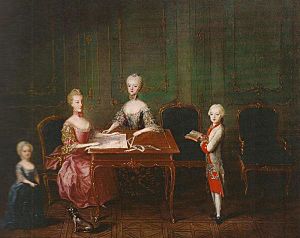
Isabella was very intelligent and well-educated. She was especially interested in philosophy, morality, music, history, physics, and metaphysics. She was also artistic. She painted, drew, sang, and played the violin. Playing the violin was rare for women at that time. She also wrote poems and studies. She studied mechanics and worked on machinery. She enjoyed sports. The imperial court and even her husband thought she was a witty conversationalist. Despite being shy, she fit in everywhere. Most people liked her. She observed others carefully and analyzed their personalities.
Her best friend, Maria Christina, described Isabella. She mentioned that Isabella was biased towards those she loved. She also changed her opinions slowly.
Isabella's physical appearance was not what was fashionable for noble ladies. She had olive skin and short hair.
Sadness and Worries
Isabella often felt very sad. She had sudden times when she could not move. She would sit and stare. It has been suggested that her problems were inherited. Both her grandfathers and her father showed similar feelings. Her mother's death also affected her greatly. She soon believed she would not live for more than four years. By 1763, her desire for death grew. She said she heard a voice telling her the end was near. This made her feel 'gentle, peaceful, festive'. It encouraged her and gave her 'mysterious power over [herself]'.
Children
Isabella had four known pregnancies during her three-year marriage to Archduke Joseph. Two ended in miscarriage. The two live births produced two daughters. Only one of them survived infancy, and neither lived to adulthood.
| Name | Birth | Death | Notes |
|---|---|---|---|
| Archduchess Maria Theresa Elizabeth Philippine Louise Josepha Joanna | 20 March 1762 | 23 January 1770 | Died at the age of 7 of pleurisy. |
| Child* | August 1762 | August 1762 | Suffered a miscarriage. |
| Child* | January 1763 | January 1763 | Suffered a miscarriage. |
| Archduchess Maria Christina | 22 November 1763 | 22 November 1763 | Born three months early and died shortly after birth. |
Images for kids
See also
 In Spanish: Isabel de Borbón-Parma para niños
In Spanish: Isabel de Borbón-Parma para niños


